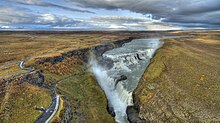Gullfoss
| Gullfoss | |
|---|---|
 Gullfoss, Iceland | |
 | |
| Location | Southwest Iceland |
| Coordinates | 64°19′34″N 20°07′16″W / 64.32611°N 20.12111°WCoordinates: 64°19′34″N 20°07′16″W / 64.32611°N 20.12111°W |
| Type | Tiered, Cataract |
| Total height | 32 m |
| Number of drops | 2 |
| Longest drop | 21 m |
| Watercourse | Hvítá River |
| Average flow rate | 140 m3/s |
Gullfoss ("Golden Falls"; ![]() Icelandic pronunciation (help·info) [ˈkʏtl̥ˌfɔsː]) is a waterfall located in the canyon of the Hvítá river in southwest Iceland.
Icelandic pronunciation (help·info) [ˈkʏtl̥ˌfɔsː]) is a waterfall located in the canyon of the Hvítá river in southwest Iceland.
History and description[]

The Hvítá river flows southward, and about a kilometre above the falls it turns sharply to the right and flows down into a wide curved three-step "staircase" and then abruptly plunges in two stages (11 metres or 36 feet, and 21 metres or 69 feet) into a crevice 32 metres (105 ft) deep. The crevice, about 20 metres (66 ft) wide and 2.5 kilometres (1.6 mi) in length, extends perpendicular to the flow of the river. The average amount of water running down the waterfall is 141 cubic metres (5,000 cu ft) per second in the summer and 80 cubic metres (2,800 cu ft) per second in the winter. The highest flood measured was 2,000 cubic metres (71,000 cu ft) per second.
During the first half of the 20th century and some years into the late 20th century, there was much speculation about using Gullfoss to generate electricity. During this period, the waterfall was rented indirectly by its owners, Tómas Tómasson and Halldór Halldórsson, to foreign investors. However, the investors' attempts were unsuccessful, partly due to lack of money. The waterfall was later sold to the state of Iceland, and is now protected.
Sigríður Tómasdóttir, the daughter of Tómas Tómasson, was determined to preserve the waterfall's condition and even threatened to throw herself down. Although it is widely believed, the very popular story that Sigríður saved the waterfall from exploitation is untrue.[citation needed] A stone memorial to Sigriður, located above the falls, depicts her profile.[1]
Gullfoss is one of the most popular tourist attractions in Iceland. Together with Þingvellir and the geysers of Haukadalur, Gullfoss forms part of the Golden Circle, a popular day excursion for tourists in Iceland.
In popular culture[]
Gullfoss appears on the cover of the album Porcupine by the British band Echo and the Bunnymen. Additionally, the falls are referenced in the novella The Odd Saga of the American and a Curious Icelandic Flock;[2] during a dinner, Snorri expresses a preference for Gullfoss, while Dr. Gustafsson favors Glymur. Gullfoss features in the music video for the single "Heaven" by the band Live. Gullfoss appears briefly in the TV series Vikings, in a side arc in Iceland.
In the third season of the animated TV series, Avatar: The Last Airbender, in the episode “Sokka’s Master”, the character Sokka learns to sword fight by the Fire Nation swordsmaster, Piandao. In one scene of the episode, Piandao takes Sokka to a waterfall which was based on Gullfoss Waterfall.
See also[]
- List of rivers of Iceland
- Waterfalls of Iceland
References[]
- ^ "Gullfoss Sigridur Tomasdottir". Nat.is. Archived from the original on 2011-10-14. Retrieved 2012-01-01.
- ^ "The Odd Saga of the American and a Curious Icelandic Flock". Google Books. Retrieved May 5, 2012.
External links[]
| Wikimedia Commons has media related to Gullfoss. |
- Canyons and gorges of Iceland
- Tourist attractions in Iceland
- Waterfalls of Iceland

